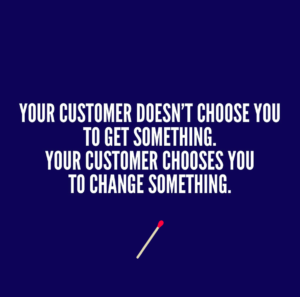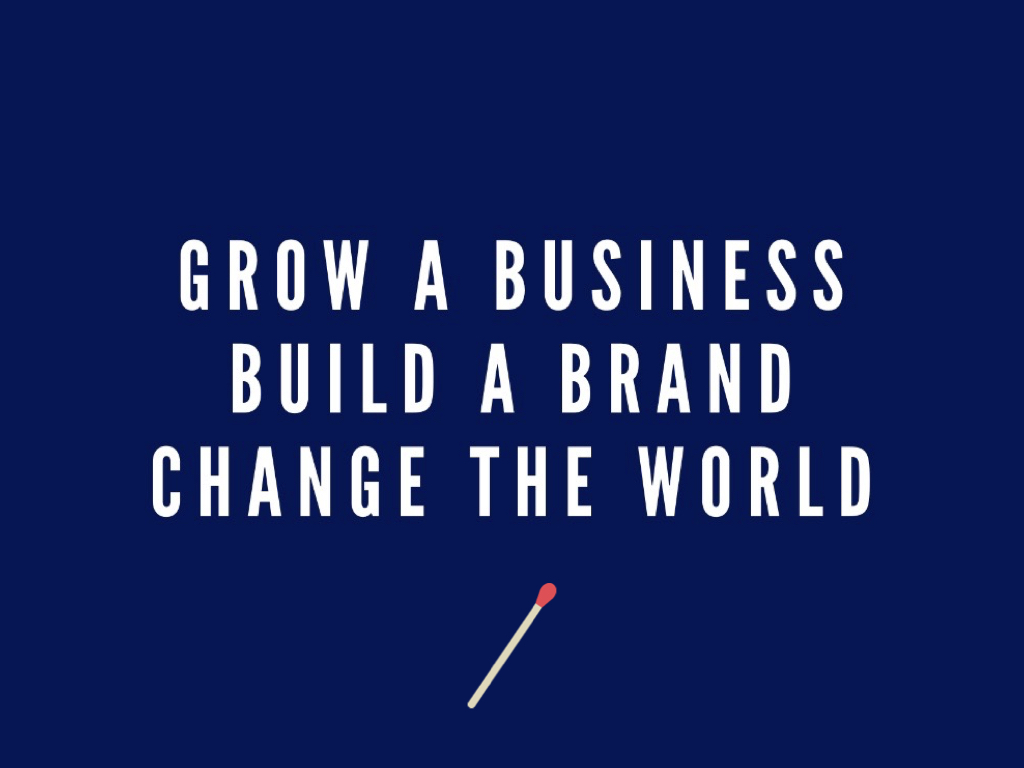By
Mark DiMassimo | 10/08/2020 | in

Warby Parker doesn’t sell eyeglasses.
Warby Parker sells a behavior change – a different way to buy eyeglasses.
Peloton Interactive doesn’t sell an exercise bike.
Peloton sells a behavior change – a way to make sure you exercise and keep exercising, no excuses.
Airbnb doesn’t sell rooms and apartments.
Airbnb sells a behavior change – a different way to travel.
Uber doesn’t sell rides.
Uber sells behavior change – a different way to get from here to there and a different way to earn a living too.
Dollar Shave Club doesn’t sell razors.
Dollar shave club sells a behavior change – a different way to buy razors.
HelloFresh doesn’t sell meal kits.
HelloFresh sells a behavior change – a way to make home cooking fit modern life.
Sun Basket doesn’t sell meal kits.
SunBasket sells a behavior change – a way to cook Paleo or Whole30 or Vegan…
Stitch Fix doesn’t sell clothes.
StitchFix sells behavior change – a totally different way to get yourself dressed.
If you’re in the direct-to-consumer business, you’re a behavior change marketer. Period.
Your customer doesn’t choose you to get something.
Your customer chooses you to change something.
You are in behavior change marketing.
Branding for behavior change is different.
Designing for behavior change is different.
Content for behavior change is different.
Advertising for behavior change is different.
Marketing for behavior change is different.
By
Team DIGO | 10/06/2020 | in
Warby Parker doesn’t sell eyeglasses.
Warby Parker sells a behavior change – a different way to buy eyeglasses.
Peloton Interactive doesn’t sell an exercise bike.
Peloton sells a behavior change – a way to make sure you exercise and keep exercising, no excuses.
Airbnb doesn’t sell rooms and apartments.
Airbnb sells a behavior change – a different way to travel.
Uber doesn’t sell rides.
Uber sells behavior change – a different way to get from here to there and a different way to earn a living too.
Dollar Shave Club doesn’t sell razors.
Dollar shave club sells a behavior change – a different way to buy razors.
HelloFresh doesn’t sell meal kits.
HelloFresh sells a behavior change – a way to make home cooking fit modern life.
Sun Basket doesn’t sell meal kits.
SunBasket sells a behavior change – a way to cook Paleo or Whole30 or Vegan…
StitchFix doesn’t sell clothes.
StitchFix sells behavior change – a totally different way to get yourself dressed.
If you’re in the direct-to-consumer business, you’re a behavior change marketer. Period.
Your customer doesn’t choose you to get something.
Your customer chooses you to change something.
You are in behavior change marketing.
Learn more about behavior change marketing here. It’s free. No funnel:
By
Mark DiMassimo | 10/06/2020 | in
Congratulations!
Today is your day.
You’re off to great places.
You’re off and away.
Out there, things happen,
And frequently do,
To people as brainy,
And footsy as you.
When things start to happen,
Don’t worry, don’t stew.
Just go right along,
You’ll start happening too.
Just step over things
That stick to your shoe
That weigh down your wings
And mess up your do.
Your briefs should be brief,
Small words straight on through,
No jargon or grief,
Just Why? What? and Who?
Oh, you’ll be of great use
Every word that you say
If you write like Dr. Suess,
And not Seuss, M.B.A.
By
Mark DiMassimo | 03/14/2019 | in

Let’s face it, we live in a world of behavior gone wrong.
Some see imminent apocalypse.
I see plenty of work for behavior change marketers and designers.
Opioid Crisis. Digital addiction. Inactivity. Unhealthy eating. Rising oceans. Uninspiring workplaces.
Pick your target. Go.
The problems that the world faces can only be solved with Behavior Change marketing and design. Growth and business success are behavior change marketing problems.
Growth problems can only be solved by behavioral solutions.
The process of behavior change marketing is simple. Determine the key performance indicators that support the growth theory for the business. Identify the behaviors that lead to those KPIs. Analyze the key behaviors along the customer journey, identifying gaps, drags and blocks.
Prioritize your design interventions. Describe the experience that will most likely transform behavior into habit for this brand.
Create experiences that will inspire action, informed by the vast store of behavioral science outcomes and deep direct response and interactive design testing experience.
Relentlessly test and optimize.
Grow a business. Build a brand. Change the world.
Let’s go, Behavior Change Marketer!
Learn more about Behavior Change Marketing by signing up for The Change Agent’s Cookbook for 2019: http://ow.ly/f1ms30nm1BL
By
Team DIGO | 12/05/2017 | in
We can help people change their decisions and habits in ways that empower and delight them.
We combine the findings of behavioral economics, mobile clinical interventions, persuasion design, direct marketing, CRM, and decades of A/B split testing and optimizations into an integrated practice of behavior change marketing.
This video of our Chief recapping his time at the Yale Behavioral Economics Intensive dives into the topic in greater detail:
Want to learn even more about Behavior Change Marketing? These articles are a great place to start:
Behavior Change Science Update: Moral Reframing
What’s different about the one-in-a-thousand organization that thrives and outperforms? That builds a brand and inspires a movement?
Inspiring Action Brand of the Month: Duolingo
If you and your team are trying to build an inspiring action brand, or know anyone else who may find this helpful, feel free to share this amongst them. If you want to join the conversation yourself, reach out to us on twitter, we’d love to hear from you.
By
Team DIGO | 10/28/2015 | in
Recently there has been an influx of ad-block applications appearing on the App Store. These apps were developed in response to consumer backlash about the amount of advertising people were receiving when browsing on their smart phones, and have thus far been popular. As of last week, the three most downloaded apps on the App Store were ad-blockers.
As a consumer, I understand some of the frustrations with mobile ads; they are often intrusive into my expected experience, they often act more as pop ups and are not inline with my scroll, and they are sometimes difficult to close with my fat thumbs. Additionally, I have found some video ads particularly annoying, as they tend to eat up my data more quickly. With that said, I also realize they may be necessary for me to continue viewing “free” content.
As a marketer, I share some of the frustrations but think most of the instances are a result of other marketers not doing an effective job of picking and choosing the placements that seamlessly integrate into the user experience. High impact sounds good and all, but if it annoys the consumer then all you are doing is drawing negative connotation to the brand and the ad.
As a marketer and consumer, I know there must be a better way to advertise and incorporate that advertising in my expected user experience. Companies like Sled Mobile are working to solve the issue by developing and serving high impact ads that are in stream with a user’s scroll, but more can certainly be done and not just from the delivery side but also from the creative and placement side.
Planners need to be working harder to ensure that the ads they are placing are in an environment where the user is getting some good content. The user will then be more closely aware that the ad is the reason why the content is free ex: YouTube, but it needs to be something relevant to them individually. Broad and untargeted placements do not work on mobile; ads should be helpful and relevant.
From a creative standpoint, there should be more emphasis on unique and dynamic messaging. Messaged should be catered to location or user activity. The adaptation of a standard desktop display ad to mobile is no longer acceptable.
Being a consumer and marketer gives me a unique perspective; however the one perspective I am not afforded is that of the content provider. What will ad-blocking applications mean for them? Unfortunately, it could mean death. With ads being blocked, we must ask how the content provider is to stay in business. Everyone loves the idea of free content but unfortunately it’s just an idea and not a reality. Everything on the back end; writers, contributors, designers and webmasters must be paid for.
How is the content provider or publisher to stay in business if they cannot monetize on their offering and recoup some of the costs associated with content creation? Native or custom content is one option, but there certainly isn’t enough demand to fund a full content offering just yet. Would users visit a site if every piece of content on there was co-created by an advertiser? I think not.
Before we all go out and start downloading ad-blockers, we should first think about the possible repercussions on the content providers we know and love.
-Dan Sauvigné, Associate Media Director, Proove Accountable Media



